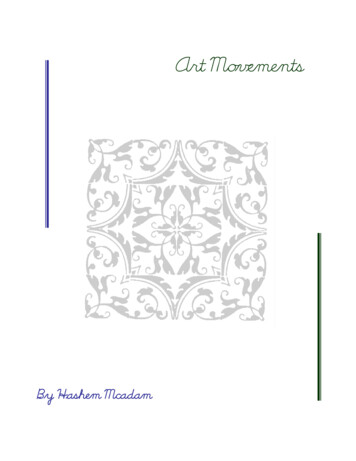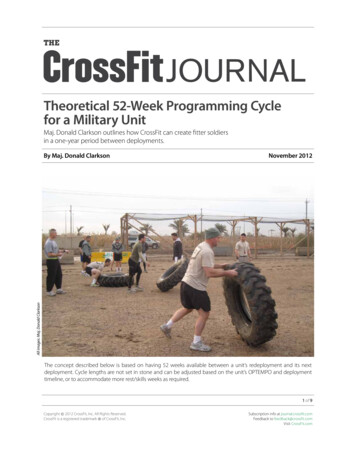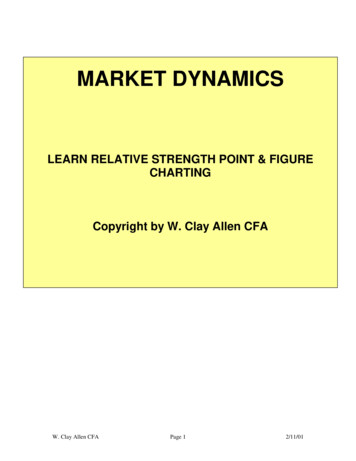
Transcription
Art MovementsBy Hashem Mcadam
Art MovementsInclinations in art during different time periods always vary, and the amount specificstyles over time is extremely vast, with each being a building block in the history of art,as it went through phases affected by not only artists but by the world around them.Movements would evolve and some styles followed like fads, whereas in today’s worldof art, movements are not followed like they were, in favour of creating one’s ownstyle. This essay will summarize 17 popular art movements comprising of; Abstract Art,Abstract Expression, Conceptual Art, Cubism, Dada, Expressionism, Fauvism,Formalism, Impressionism, Modernism, Pop Art, Post Modernism, Primitivism,Surrealism, Tachisme, Realism, and Romanticism.Abstract ArtAbstract Art is a style of art where by there is no direct representation of real actualworld entities but rather colour and shape are used to produce a personal meaning, ormerely something of pleasing aesthetic value. The time art which could be classified asabstract goes back centuries, however from 1911 arts emerged which would be seenas full abstract pieces which started its modern incarnation which can still be seen tothis day. These early pioneers of the art form included Wassily Kandinsky, NataliaGoncharova and Mikhail Larionov. Abstract is a broad category which encapsulatesother, more specific art movements such as cubism and abstract expressionism.The main concept is not to make an accurate, realistic representation of something butto take an object and exaggerate or simplify it using its form/shape, and colours.Wassily Kandinsky (1913).Hashem McAdam304801082
Natalia Goncharova (1913).Mikhail Larionov (1919)Hashem McAdam304801083
Abstract ExpressionAbstract Expressionism was a movement of abstract style art which originated in NewYork City, and was prominent during the time period of 1940-1955. The concept wasto display, through abstract art, emotion and expression rather than objects. Thesearts often attempted to display a reality of the artists mind, or simply other than thereal world. These arts would commonly be made through spontaneous inclusion oflines, shapes, forms, and colour. A few abstract expressionists of the movementincluded Helen Frankenthaler, Joan Mitchell, and Barnett NewmanJoan Mitchell (1955)Helen Frankenthaler (1952)Hashem McAdam304801084
Barnett Newman (1949)Conceptual ArtThis was an art movement of the 1960’s and 1970’s which would involve the artrepresenting ideas or concepts behind the art itself. For example Piero Manzoni’s SocleDu Monde (“Base of the world”) is an art based on the concept that it holds up theworld. Although physically it is merely a block with the words “Socle Du Monde” placedupside down, it is about the concept encapsulating it. Interestingly this man alsoexhibited and sold tins of his own faeces, and balloons of his breath. The aestheticvalue therefore appeared to be of little importance in art of this movement. Otherartists of this movement included Yves Klein and Eleanor Antin.Eleanor Antin (1971)Hashem McAdam304801085
Piero Manzoni (1962)Yves Klein (1960)Hashem McAdam304801086
CubismThe Cubist art movement was a phase between 1907 and 1920. The look of this artinvolves segmenting objects and arranging the pieces in abstracted form, and frommultiple viewpoints or perspectives. The segments would often be small cube-likegeometric shapes with various angles of view, size, orientation, etc. The movementinvolved highly analytical work, especially during the first sub-phase, with the secondbeing coined the “Synthetic Phase”. Pablo Picasso was an early pioneer of this artmovement, and other artists included Georges Braque and Maria Blanchard.Georges Braque (1913)Picasso (1913)Maria Blanchard (1917)Hashem McAdam304801087
DadaThis was an art movement from 1915-1923 which rejected popularized aestheticvalues, and attempted to create bizarre, nonsensical “anti-art”. Dadaism was also acultural movement of a post World War I era, and the artworks tended to have noimplied meaning. The works often mocked the artwork or styles of other artists, andthe most popular example of dada seems to be Marcel Duchamp’s mockery of theMona Lisa (see below). This highly anti-standard type of art was to be an influence tolater art movements such as Surrealism and Pop Art, and artists of the movementincluded Hannah Höch and Max Ernst.Hannah Höch 1919Marcel Duchamp (1919)Max Ernst (1921)Hashem McAdam304801088
ExpressionismExpressionists were artists prominent from 1905-1925, who’s artwork would useexaggerated expression and distortion to display some emotional effect. Themovement was popularised in Northern Europe. A very famous and recentlycontroversial example which influenced up and coming artists of this movement wasEdvard Munch’s “The Scream”, with later artists such as Oskar Kokoschka, MarcChagall and Gabriele Münter.The aesthetic look of these artworks was often abstract. Distorting lines and shapeswas common practice in expressionism, with use of exaggerated colours and brushstrokes.Oskar Kokoschka (1914)Marc Chagall (1943)Gabriele Münter (1911)Hashem McAdam304801089
FauvismThis movement is based on the French term “fauve” which means “wild beast”. Thisterm relates to the art through the wild, bold use of colours, and often spontaneousdistorted look to the paintings. The signature look of paintings was bright with vividcolours and simple lines. Few artists followed this movement besides its early pioneersHenri Matisse and André Derain. The movement was between the period 1905-1908,and other participants included painters such as Marguerite Thompson Zorach.Henri Matisse (1905)Marguerite Thompson Zorach (1940)André Derain (1906)Hashem McAdam3048010810
FormalismFormalism whilst not being a particular movement was a period in Modern art from thelate 1800’s to the 1960’s where form in art took priority over realism. It gaveemphasis to shape, colour, texture, lines and contrast in art. In this post-impressionistperiod, the basis of formalism gave rise to other art movements such as cubism,conceptual art, minimalism, and to some degree, pop art.ImpressionismThis art movement started in the late 19th century through the works of Frenchpainters whose work would focus on the effects of light and colour. Impressionism wasmainly a representational art form, with nature and life subjects featuring prominently.With the focus on light and colour, impressionist painters attempted to give moreaccurate representations of real life equivalents. The period whilst not conciselyrestricted to the time of the particular movement was between1860-1900, and likeother movements gave birth to or influenced some other art movements. Impressionistartists included pioneer Claude Monet, Pierre-Auguste Renoir, and Mary StevensonCassatt.Mary Stevenson Cassatt (1893)Hashem McAdamPierre-Auguste Renoir (1876)3048010811
Claude Monet (1899)ModernismModernism was again more of an overall movement which simply signified the changefrom traditional art forms and the strive to create more complex artworks which wereabstract and expressionist in form. It was a movement containing many othermovements; which made the move away from conventional artwork, and happenedduring the period of 1890-1940. It was an overall tendency pioneered by artists suchas Paul Cézanne, Edouard Manet, and Sigrid HjerténEdouard Manet (1864)Hashem McAdamSigrid Hjertén (1916)3048010812
Paul Cézanne (1876)Pop ArtThe Pop Art movement was one which was influenced by popular culture, and was amove against art of its time (1950-1969) similarly to Dadaism. It commonly usedtechniques similar in aestheticism to advertising and mass media. It was a responseagainst the seriousness of abstract expressionism. It would involve commonplacepeople and items of the time such as soda bottle and soup cans, particularly the workof Andy Warhol who was an establisher of pop art. Other pop artists of the movementincluded Roy Lichtenstein, and British artist Pauline Boty.Andy Warhol (1968)Hashem McAdamRoy Lichtenstein (1965)3048010813
Pauline Boty (1963)Post ModernismPost modernism is an overall reference to a wide range of cultural occurrences andsubjects, including many art movements. It is a term which became common in the1970’s, for a technically controversial designation of a period between 1960 and today.The basis of the idea of modernism is that it is the move from modernism, includingart movements before this time. It is an overall subject concerning itself with areassuch as deconstruction, idea of reality, simulacra (Baudrillard), and structuralism.Artists whose works are considered post-modern include those in the art movementperiods within that of post modernism, including those such as Andy Warhol and otherpop artists.PrimitivismPrimitivism [1890-1950] was an art style whereby artists would display bizarre worksattempting to make touch with the ‘primitive’ side of the world, and highlight thephenomena of the European /Western world which was argued to have lost touch withprimitive aspects. Early pioneer Henri Rousseau argued that the 18th century art lacked“nature, passion, emotion, instinct and mysticism”, which brought about the focus onhighlighting these aspects of difference. Much of this original primitive style artdisplayed a rough look giving outlooks on ‘primitive’ life including African culturalthemes and ritualistic aspects. Other artists who can be classified into this movementinclude “Grandma Moses”, and Paul Gauguin.Hashem McAdam3048010814
Paul Gauguin (1897)Henri Rousseau (1907)Grandma Moses (1946)SurrealismThis was a movement which started in 1920’s France and lasted through the 1930’s. Itwas an art movement displaying works which played on the idea of reality and dreams.Artists would also create works which attempt to transform the real world. An exampleis the work of René Magritte shown below, of which the text translates into “this is nota pipe”. Some other Surrealists were Dorothea Tanning and Salvador Dalí.Hashem McAdam3048010815
René Magritte (1929)Dorothea Tanning (1946)Salvador Dalí (1937)Hashem McAdam3048010816
TachismeTachisme was more or less a style of abstract expressionism, prominent inFrance/Europe in the 1940’s and 50’s. Tachist artists had a more spontaneous touch totheir artwork, with a common look of blotches and splashed paint which involved muchuse of gestures and actions. Example of Tachist artists are Georges Mathieu, MariaHelena Vieira da Silva and Hans Hartung.Georges Mathieu (1950)Hans Hartung (1951)Maria Helena Vieira da Silva (1949)Hashem McAdam3048010817
RealismRealism [1840-1880] was a very general movement which rejected dramaticromanticism and produced artwork of real to life scenes. Subjects in the artworks hadclosely representational colour, shadows and features, without abstract focus. Realistart included that of James Abbott McNeill Whistler, Honore Daumier and Rosa Bonheur.J A McNeill Whistler (1863)Honore Daumier 1860Hashem McAdamRosa Bonheur (1872)3048010818
RomanticismThe romanticism art movement was evident during the key dates of 1800-1880. It is adeeply emotional style of art with intellectual value. Expression was spontaneous,giving precedence to feeling rather than reason. The style of painting was commonlyenergetic and dramatic, and often featured nature as a source of the emotional content.Some artists of the movement were Caspar David Friedrich, Marie-Louise-ElisabethVigee-Lebrun, and Eugene Delacroix.Caspar David Friedrich (1818)Marie-Louise-Elisabeth Vigee-Lebrun (1799)Eugene Delacroix (1830)Hashem McAdam3048010819
as full abstract pieces which started its modern incarnation which can still be seen to this day. These early pioneers of the art form included Wassily Kandinsky, Natalia Goncharova and Mikhail Larionov. Abstract is a broad category which encapsulates other, more specific art move










